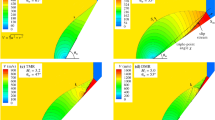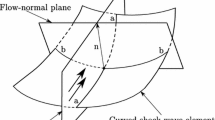Abstract
A new model to predict internal axisymmetric shocks with Mach reflections at their centreline is developed, and results are compared with an Eulerian flow solver, termed CFD herein. The model combines the method of characteristics with the equations for quasi-one-dimensional flow. Calculations are conducted for a range of axisymmetric wedge geometries, and the effects of wedge length and shock angle at the wedge leading edge are studied. These various wedge geometries are found to generate flowfields with similar flow features, with Mach discs that vary greatly in size. This observation forms the basis of a method that uses the results from a CFD mesh convergence study, conducted for a single wedge geometry, to determine the mesh resolution requirements and uncertainty due to finite mesh resolution for all other wedge geometries. When uncertainties due to the effects of finite mesh resolution are considered, it is shown that either the differences between model results and CFD results for Mach disc radius are small, or the results are almost indistinguishable from one another. The model indicates that these geometries generate a flowfield that can be treated as two separate parts: one supported by the wedge surface and another supported by the sharp corner at the wedge trailing edge. The influence of these separate flowfields on the incident shock, flow properties along the slip-line, and the size of the Mach disc is assessed.











Similar content being viewed by others
Change history
27 December 2021
A Correction to this paper has been published: https://doi.org/10.1007/s00193-021-01068-w
References
Melnikov, D.A.: Reflection of shock waves from the axis of symmetry. USSR Acad. Sci. Mech. Mech. Eng. 3, 24–30 (1962)
Rylov, A.I.: On the impossibility of regular reflection of a steady-state shock wave from the axis of symmetry. Appl. Math. Mech. 54(2), 245–249 (1990). https://doi.org/10.1016/0021-8928(90)90034-8
Mölder, S., Gulamhussein, A., Timofeev, E., Voinovich, P.A.: Focusing of conical shocks at the centerline of symmetry. In: Houwing, A.F.P. (ed.) Proceedings of the 21st International Symposium on Shock Waves, vol. 2, pp. 875–880 (1997)
Ben-Dor, G.: Shock Wave Reflection Phenomena, 2nd edn. Springer, Berlin (2007). https://doi.org/10.1007/978-3-540-71382-1
Ferri, A.: Application of the method of characteristics to supersonic rotational flow. NACA-TR-841 (1946)
Isakova, N.P., Kraiko, A.N., P’yankov, K.S., Tillyayeva, N.I.: The amplification of weak shock waves in axisymmetric supersonic flow and their reflection from an axis of symmetry. J. Appl. Math. Mech. 76(4), 451–465 (2012). https://doi.org/10.1016/j.jappmathmech.2012.09.013
Gounko, Y.P., Mazhul, I.I.: Numerical modeling of the conditions for realization of flow regimes in supersonic axisymmetric conical inlets of internal compression. Thermophys. Aeromech. 22(5), 545–558 (2015). https://doi.org/10.1134/S0869864315050030
Azevedo, D.J., Liu, C.S.: Engineering approach to the prediction of shock patterns in bounded high-speed flows. AIAA J. 31(1), 83–90 (1993). https://doi.org/10.2514/3.11322
Schotz, M., Levy, A., Ben-Dor, G., Igra, O.: Analytical prediction of the wave configuration size in steady flow Mach reflections. Shock Waves 7, 363–372 (1997). https://doi.org/10.1007/s001930050091
Li, H., Ben-Dor, G.: A parametric study of Mach reflection in steady flows. J. Fluid Mech. 341, 101–125 (1997). https://doi.org/10.1017/S0022112097005375
Mouton, C.A., Hornung, H.G.: Mach stem height and growth rate predictions. AIAA J. 45(8), 1977–1987 (2007). https://doi.org/10.2514/1.27460
Roy, S., Gopalapillai, R.: An analytical model for asymmetric Mach reflection configuration in steady flows. J. Fluid Mech. 863, 242–268 (2019). https://doi.org/10.1017/jfm.2018.945
Omel’chenko, A.V., Uskov, V.N., Chernyshev, M.V.: An approximate analytical model of flow in the first barrel of an overexpanded jet. Tech. Phys. Lett. 29(3), 243–245 (2003). https://doi.org/10.1134/1.1565647
Gao, B., Wu, Z.N.: A study of the flow structure for Mach reflection in steady supersonic flow. J. Fluid Mech. 656, 29–50 (2010). https://doi.org/10.1017/S0022112010001011
Tao, Y., Liu, W., Fan, X., Xiong, B., Yu, J., Sun, M.: A study of the asymmetric shock reflection configurations in steady flows. J. Fluid Mech. 825, 1–15 (2017). https://doi.org/10.1017/jfm.2017.280
Lin, J., Bai, C.-Y., Wu, Z.-N.: Study of asymmetrical shock wave reflection in steady supersonic flow. J. Fluid Mech. 864, 848–875 (2019). https://doi.org/10.1017/jfm.2019.18
Délery, J.: Handbook of Compressible Aerodynamics. Wiley-ISTE, Hoboken (2010)
Shapiro, A.: The Dynamics and Thermodynamics of Compressible Fluid Flow, vol. 1. The Ronald Press Company, New York (1953)
Masterix, ver. 3.40. RBT Consultants, Toronto (2003–2015)
Saito, T., Voinovich, P., Timofeev, E., Takayama, K.: Development and application of high-resolution adaptive numerical techniques in Shock Wave Research Center. In: Toro, E.F. (ed.) Godunov Methods: Theory and Applications, pp. 763–784. Kluwer Academic, New York (2001). https://doi.org/10.1007/978-1-4615-0663-8
Roy, C.J.: Grid convergence error analysis for mixed-order numerical schemes. AIAA J. 41(4), 595–604 (2003). https://doi.org/10.2514/2.2013
Grozdovskii, G.L.: Supersonic axisymmetric conical flows with conical shocks adjacent to uniform parallel flows. Prikl. Mat. Mekh. 23(2), 379–383 (1959)
Mölder, S.: Internal, axisymmetric, conical flow. AIAA J. 5(7), 1252–1255 (1967). https://doi.org/10.2514/3.4179
Acknowledgements
The research is supported by the National Science and Engineering Research Council (NSERC), Canada, via a Discovery grant. B.S. gratefully acknowledges the McGill Engineering Doctoral Award (MEDA) funded in part by the Faculty of Engineering, McGill University. Rabi Tahir’s support regarding the Masterix code is greatly appreciated.
Author information
Authors and Affiliations
Corresponding author
Appendix
Appendix
The accuracy of the MOC code is assessed by comparison against a theoretical internal conical flow (ICF) [22, 23]. ICF can be characterised by a constant strength axisymmetric conical shock, with a downstream pointing apex, and can be predicted by solving the Taylor-Maccoll equations. A conical shock angle is selected, and the Taylor-Maccoll equations are integrated numerically starting from the conditions downstream of the conical incident shock. The solution yields a streamline, which may be viewed as a solid axisymmetric surface supporting the conical shock, and this surface is used to generate MOC predictions.
An ICF solution was generated for a freestream Mach number \(M_{\mathrm{1}}=3.0\), a shock angle \(\beta _{\mathrm{t}}=150^{\circ }\), and for \(\gamma =1.4\). MOC calculations were then generated for \(\Delta c=0.001\), 0.002, 0.004, and 0.008. The average shock angle, \(\overline{\beta }\), was then compared to the theoretical value. The difference between \(\overline{\beta }\) and \(\beta _{\mathrm{t}}\) is plotted in Fig. 11. A generalised Richardson extrapolation method [21] was applied to results from the three finest meshes, indicating an error in shock angle of \(-1.3\times 10^{-5}\)deg as \(\Delta c\) tends to zero.
Rights and permissions
About this article
Cite this article
Shoesmith, B., Timofeev, E. Modelling of Mach reflections in internal axisymmetric steady supersonic flow. Shock Waves 31, 945–957 (2021). https://doi.org/10.1007/s00193-021-01047-1
Received:
Revised:
Accepted:
Published:
Issue Date:
DOI: https://doi.org/10.1007/s00193-021-01047-1




